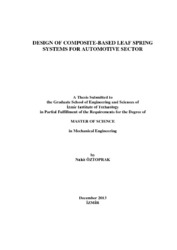Please use this identifier to cite or link to this item:
https://hdl.handle.net/11147/3679Full metadata record
| DC Field | Value | Language |
|---|---|---|
| dc.contributor.advisor | Tanoğlu, Metin | en |
| dc.contributor.author | Öztoprak, Nahit | - |
| dc.date.accessioned | 2014-07-22T13:52:08Z | - |
| dc.date.available | 2014-07-22T13:52:08Z | - |
| dc.date.issued | 2013-12 | en |
| dc.identifier.uri | http://hdl.handle.net/11147/3679 | - |
| dc.description | Thesis (Master)--Izmir Institute of Technology, Mechanical Engineering, Izmir, 2013 | en |
| dc.description | Includes bibliographical references (leaves: 88-92) | en |
| dc.description | Text in English; Abstract: Turkish an English | en |
| dc.description | xii, 92 leaves | en |
| dc.description | Full text release delayed at author's request until 2016.12.27 | en |
| dc.description.abstract | The applications of fiber reinforced polymeric composites in several engineering fields such as automotive, aviation, defense industry and marine are observed vastly nowadays. Especially in the automotive industry, the necessity of the reduction of fuel consumption and CO2 emission has entailed the utilization of the composite materials to provide weight reduction without sacrificing any material strength. Conventional steel leaf springs are components significantly affecting the weight of the vehicle as well as providing ride comfort and vehicle stability. Hence, fiber reinforced polymeric composites having many outstanding properties such as low density, high strength, corrosion resistance, high fatigue life, high wear resistance, are convenient materials for these types of applications. In this thesis, three different composite-based mono leaf springs were designed and analyzed. It was inferred from the analyses that 0° unidirectional glass fiber system hasn’t generated the intended spring rate accurately. Consequently, alternating configurations of the glass and carbon hybrid systems were studied. It was deduced from the studies that material configuration of [0°6G/0°2C/0°22G]S was generated the intended spring rate. Three different composite-based mono leaf springs including indicated material configurations were fabricated within the thesis study. Manufactured prototypes were also tested by using leaf spring test rig for determining the behavior of the prototypes experimentally. The obtained results were compared with FEA and it has been observed that the results are in compliance. | en |
| dc.language.iso | en | en_US |
| dc.publisher | Izmir Institute of Technology | - |
| dc.rights | info:eu-repo/semantics/openAccess | en_US |
| dc.subject.lcsh | Composite materials in automobiles | en |
| dc.subject.lcsh | Leaf springs | en |
| dc.subject.lcsh | Finite element method | en |
| dc.title | Design of composite-based leaf spring systems for automotive sector | en_US |
| dc.type | Master Thesis | en_US |
| dc.institutionauthor | Öztoprak, Nahit | - |
| dc.department | Thesis (Master)--İzmir Institute of Technology, Mechanical Engineering | en_US |
| dc.relation.publicationcategory | Tez | en_US |
| item.languageiso639-1 | en | - |
| item.fulltext | With Fulltext | - |
| item.openairecristype | http://purl.org/coar/resource_type/c_18cf | - |
| item.openairetype | Master Thesis | - |
| item.grantfulltext | open | - |
| item.cerifentitytype | Publications | - |
| Appears in Collections: | Master Degree / Yüksek Lisans Tezleri | |
Files in This Item:
| File | Description | Size | Format | |
|---|---|---|---|---|
| 10013312.pdf | MasterThesis | 2.28 MB | Adobe PDF |  View/Open |
CORE Recommender
Page view(s)
240
checked on Jul 22, 2024
Download(s)
1,062
checked on Jul 22, 2024
Google ScholarTM
Check
Items in GCRIS Repository are protected by copyright, with all rights reserved, unless otherwise indicated.